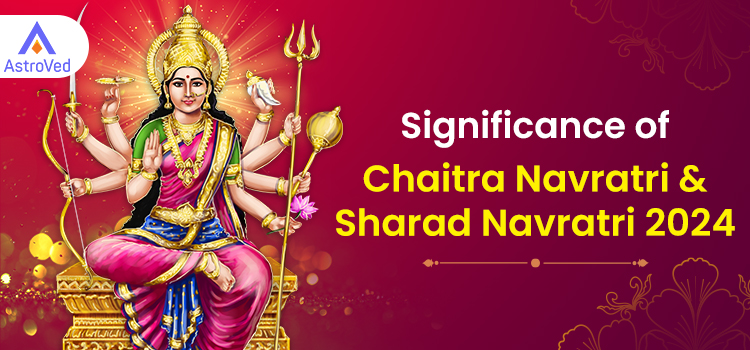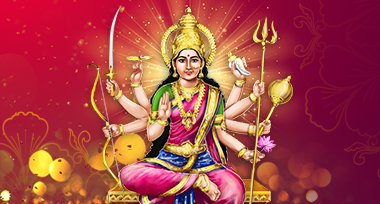Navratri is one of the most significant festivals that celebrates the Divine feminine energy of Mother Shakti, the Supreme Power and Consciousness. Navratri is nine days of devotion, faith and enthusiasm observed with prayers, fasting and making sacred offerings to Goddess Durga, the impregnable fortress of protection and strength. In Sanskrit, ‘Navratri’ means nine nights.
This highly auspicious festival is celebrated across five seasons- Chaitra, Ashadha, Sharad, and Paush. The most prominent among them is Vasant Navratri, observed in the month of Chaitra Mar-Apr) with the onset of spring and Sharad Navratri was observed in the month of Ashwin (Sep-Oct) in autumn.
Power of Durga, The Benevolent Goddess
Goddess Durga, who emerged as the Divine feminine energy of the combined powers of the Trimurti and other Gods, went on to defeat evil forces, especially the demon Mahishasura, who, after gaining boons, became very powerful and created havoc in all the worlds.
The embodiment of strength, she is known for her protective nature and gives the courage and strength to face enemies and challenges. Although she is a fierce Warrior Goddess, she is benevolent and compassionate. She helps overcome delusion and ignorance.

What is Chaitra Navratri?
Chaitra Navratri is observed in the month of Chaitra (Mar-Apr) and is also known as Vasant Navratri. This nine-day festive ushers in the spring season and falls in the month’s Shukla Paksha (Bright Lunar Fortnight). Mostly celebrated across North and Western India, different regions observe the holy period of Chaitra Navratri, calling it by other names.
The festival is dedicated to the Tridevi, with Mother Shakti as Goddess Durga, Goddess Lakshmi and Goddess Saraswati. Goddess Durga is traditionally worshipped in the spring season. According to the Puranas, Goddess Durga is traditionally offered worship in late spring.
Significance of Chaitra Navratri
Chaitra Navaratri is the original period of the Navratri festival, which celebrates Goddess Durga’s birth of the cosmos and all its living things. According to the scriptures, Brahma, the Creator, started the creation of the Universe at the bidding of Goddess Durga.
Another belief is that Shiva allowed his consort, Goddess Parvati (Mother Goddess), to visit her parent’s home for nine days (Chaitra Navratri). It is believed she annihilated the demon Mahishasura during this period, which signifies the victory of good over evil. Each day of this Navratri has its colour. Flower offerings are made to the deity, an essential ritual as a particular flower is associated with every Divine form of the Goddess.
The nine-day festival worships her nine Divine incarnations, each celebrating a different manifestation of the Goddess. Chaitra Navratri is also associated with Ram Navami, the birthday of Sri Ram, on the ninth day of Chaitra Navratri. Hence, this festival is also known as Ram Navratri.
What is Sharad Navratri?
According to scriptures, Sri Ram is believed to have offered worship to Goddess Durga and invoked her in the form of Astam (Eight) Mahavidya (Maa Bagla) due to the battle he had to wage against Lanka King Ravana and rescue Sita Devi.
Sri Ram performed this Pooja in the autumn season (Hemant Ritu) of Ashwin (Sep-Oct), as mentioned in the Krittibas Ramayana, which is called Akal Bodhan (Out of Season Worship or Untimely Invocation of Goddess Durga), which came to be celebrated as Sharad Navratri. She was pleased with his worship and bestowed blessings accompanied by her powers that helped him win the battle. This period is celebrated as Sharad Navratri.
Significance of Sharad Navratri
Sharad Navratri is the most significant Navratri and is also called Maha Navratri. It is celebrated in the Ashwin month (Sep-Oct) during autumn and dedicated to the nine forms of Goddess Shakti- Durga, Bhadrakali, Jagdamba, Annapoorna, Sarvamangala, Bhairavi, Chandika, Lalita, Bhavani and Mookambika.
Navratri signifies the destruction of Mahishasura by the Goddess, and the tenth day is celebrated as Vijayadashami or Dussehra, with giant effigies of Ravana burnt, symbolising the victory of good over evil. During this period, Sri Ram is also believed to have offered prayers to Mata Durga to receive her powers to overcome Lanka King Ravana and rescue Sita Devi. In South India, worship is offered to Goddesses Durga, Lakshmi and Saraswati.
The celebration holds deep spiritual significance and a renewal of faith with fasting and Poojas. It is celebrated as Durga Pooja in West Bengal and Assam for nine days. Sharad Navratri indicates the beginning of the autumn season. This Navratri also holds great cultural and social significance with devotional singing and traditional dances.
This festival upholds the power of Divine intervention and is a time for worship, devotion and celebration.


